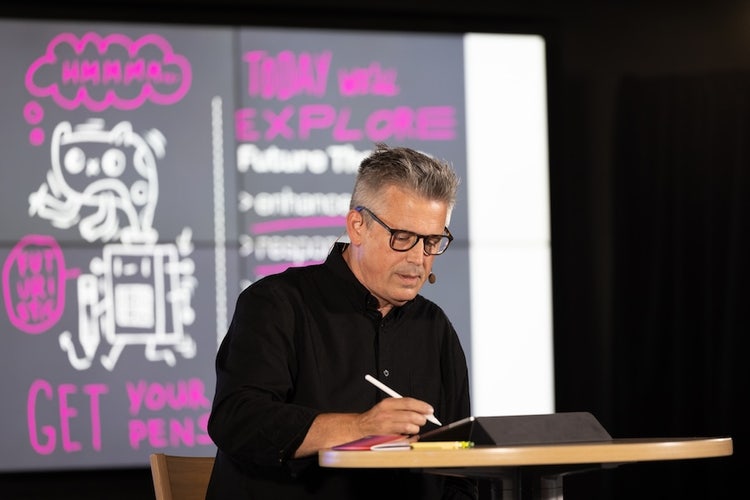What we learned at Adobe Design Summit 2024
Ideas and insights from our annual celebration of design

All photography by Myleen Hollero
Our distributed team gathered in office hubs around the world for dedicated time to connect and learn. Speakers from inside and outside of Adobe urged the members of Adobe Design to live courageous creative lives, leverage our humanity to future-proof our careers, make play a part of our design practice, and embrace the contradictions of design.
These are the big, bold ideas that have stuck with us.
Innovation happens when edge cases become the center
Eric Snowden (VP of Design, Head of Adobe Design) during a fireside chat with Scott Belsky (Chief Strategy Officer and EVP, Design & Emerging Products), touched on the topic of innovation.
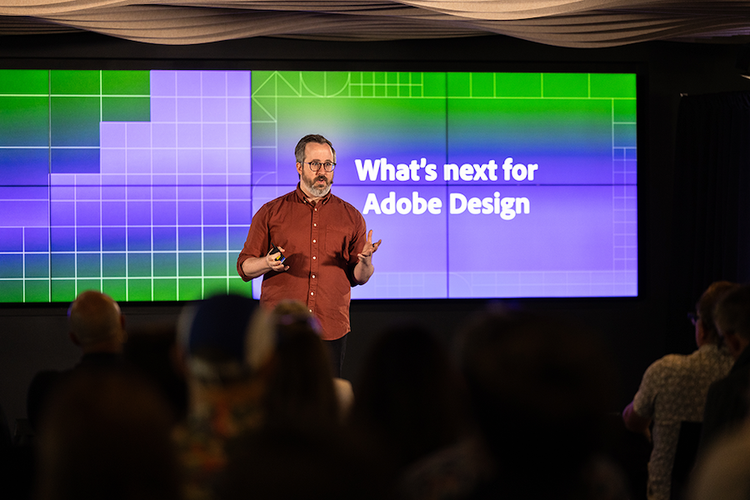
When examining his personal definition of innovation, Scott explained “Innovation is the edge cases that may someday become the center. It’s the stuff that may be relevant but isn't entirely clear right now (if it is entirely clear, it's not innovation).” Edges are the provocative boundaries that may become relevant. At first, they're uncomfortable, but as the concept is fine-tuned, the customer becomes clear, and the problem and solution are better understood, you start to realize that it could eventually be a new way that things are done. We need those edges.
Frisson is a harbinger of transformation
Dan Cooney (Director, Design Operations) took the audience on a journey of transformation: A frisson is in the air. A frisson is a strong feeling of excitement, of fear, and thrill. It’s that sensation of being overwhelmed by a performance or the chill you feel right before a roller coaster drops, and it’s always present when something big is about to happen.
As artificial intelligence leads us toward an inflection point, that dissonance offers a unique opportunity for design teams: “As divergent thinkers, we can lead through transformation by leveraging our storytellers, our analytical thinkers, our wordsmiths, our craftspeople, and our orchestrators.”
Storytelling is inherently human, and a trait of a future-proof designer
Samantha Warren (Senior Director of Design, Machine Intelligence & New Technology) described how technology has always evolved jobs in art and design. As machines get better at the tasks they’re trained to do, designers must focus more on the human aspects of their work.
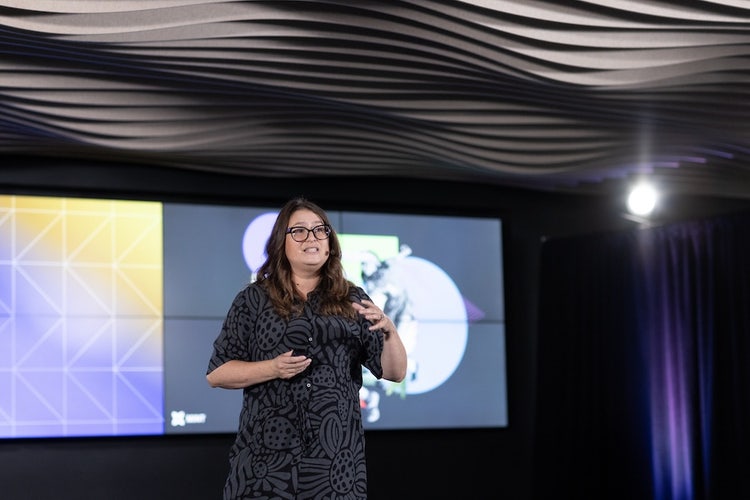
We can start by strengthening our stories. “Storytelling is inherently human, and a trait of a future proof designer. An artwork's value is deeply intertwined with context, timing, society, perception, and of course, a good story. A Jackson Pollock could be just a splash of paint on a canvas by just about anyone else, but it was timing and the context of that splash of paint that made him famous and his paintings valuable. Story delivers context and it creates value. Much like in the art world, design comes with a story, a feeling and emotion, and that is what will bring value.”
As designers, we’re here to transform, not to win
Tina Roth Eisenberg is a Swiss-born and raised graphic designer and entrepreneur, who describes herself as a stubbornly optimistic, New York-based human gatherer. She looked back at her 25-year career to uncover one of her personal insights for living a courageous creative life: As designers, we’re here to transform, not to win.

“I believe that everything is energy and that we're all connected, and we're either contributing or taking from this invisible field that surrounds us all. On a daily basis, I ask myself, 'What energy am I contributing?’ because at the end of the day, I'm grounded in the belief that the world can be better, but we need optimism to move forward.
“Creativity is a discipline in optimism. It is repeatedly choosing curiosity over fear. If every time we wobble, we ask ourselves ‘What if this turns out better than I could ever imagine?,’ we can intentionally and thoughtfully choose curiosity, optimism, and idealism over fear.”
Hypotheses, no matter how brilliant, are not evidence
Sharma Hendel (Director Experience Research, Adobe Design Research & Strategy) and Brenda Weitzer (Senior Experience Research Manager, Adobe Design Research & Strategy) explained how research can help teams ensure their ideas are good, well supported, and likely to be successful: “Presenting design concepts from a position of strength means having evidence that an idea is good, has a clearly identifiable audience, and solves a real need. Hypotheses, no matter how brilliant, are not ‘evidence.’”
Evidence requires having a hypothesis, then systematically gathering information to determine whether it’s true. Teams should never be afraid to ask for the business justifications of pursuing a specific audience or for evidence-based descriptions of a target user—otherwise, they can’t know that they’re building for the right audience.
No matter the journey, it’s the people along the way who will matter most
When Russell Preston Brown (Senior Principal Designer, Digital Imaging) joined Adobe in 1985, the future was desktop publishing. Postscript had debuted and designers could sit in their offices with early Macintoshes and laser writers, and print pages in full color with text, graphics, and images. Something they had never been able to do before. In his conversation with Matthew Richmond (Senior Director of Design, CC Pro Products) he reflected on the historically important journey that changed almost every aspect of professional design practice.
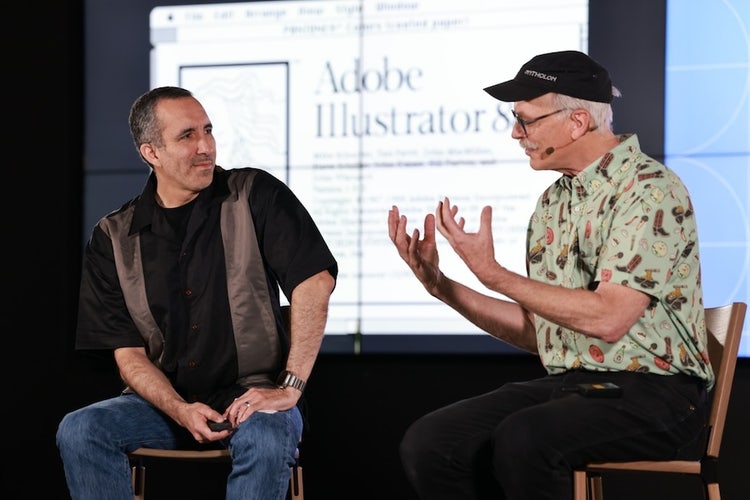
Looking back on a 40-year career, the one constant has been the people on his teams. He still sees his greatest contribution as hiring people who were smarter and better designers than him. His words of wisdom: “Connect with people, identify great design, and praise beautiful work.”
Do simple things right to do complex things well
Archana Thiagarajan (Senior Director of Design, Experience Cloud) characterized trust as the emotional currency of human interaction. It plays an undeniable role in the choices and decisions we make every day. But trust in the age of artificial intelligence means understanding the excitement surrounding it while also noting peoples’ curiosity, concern, insecurity, and ambivalence.
With new technologies there’s a temptation to move quickly toward implementation. But, more than ever, teams must carefully consider how moving too quickly affects products, experiences, and workflows. “Do simple things right to do complex things well. Paying attention to craft when working on small details can reveal insights that help to do things that are consequential.”
Embrace the contradictions of artificial intelligence
Sudeep Chaudhuri (Director of Design, Document Cloud) opened with a history of design in India. Rich in thought, craft, and jugaad (ingenuity and imagination in problem-solving) it’s an interplay of opposing forces and contradictions that fueled his growth as a designer.
He sees similar contradictions surrounding artificial intelligence: “There's a rush to make it an indispensable part of our creative lives, but it's hard to ignore what could be a disruption to human creativity, to challenge social structures, frameworks of intimacy, memory, biography, and personal idiosyncrasy—which are all great contributors to design.”
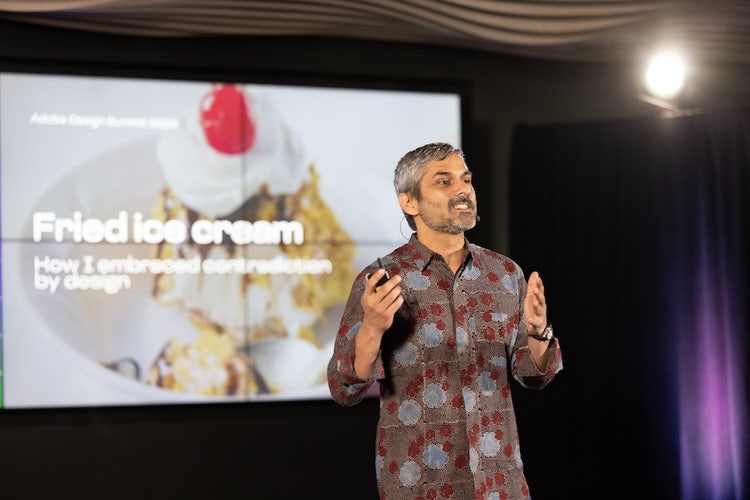
We are at a crossroads because it all feels very unpredictable: If the output is great from something automated, where does it leave creators?
Like photography—which eventually led to Impressionism, Cubism, Surrealism, and Pop Art—artificial intelligence will alter the course of creative output. Also, like photography, it can only serve to enhance human creativity because without the uniqueness of human craft, the elegance of solutions, and the ability to reflect and be inspired, AI is nothing. Art and design require a continuing journey of embracing new tools, finding the sweet spot between craft and commerce, balancing perfection and practicality, and being comfortable with the unknown.
Design for the individual ways people interact around creative work
Tara Kola (Senior Experience Researcher, Adobe Design Research & Strategy) defines experience design as the art of providing moments of excellence for the people using your product when you aren't physically present. It’s understanding users with such nuance that they feel care and belonging in the situations they need you.

“Whether we are designing products for a creative professional in San Francisco who you think you understand perfectly, or a yoga studio owner in Romania or marketer in India, we can’t assume to know the people who use our products without taking the time and the care to listen to them. Design for the individual ways people interact around creative work. Do rigorous research, testing and iteration to build the cultures and systems that celebrate usability and get details right for people around the world.”
Play provides the magic for innovation and transformation
Nishat Akhtar (Artist, Designer, and Chief Creative Officer at Instrument) says, “Good design requires strategic understanding plus a bit of surprise and wonder. When processes become formulaic, they can create distance between a designer’s point of view and innovation. Play is a natural human way to innovate and experiment and can provide the magic to keep things progressing.”
Play is part of a practice that understands how quickly things are changing—tools, styles, what people need, and how they engage. Play suspends reality and ushers in imagination. It allows us to look at things in new ways. Play is many things: it is active imagination, a space for exploration, reinterpretation, and improvisation, and it is curiosity about how mistakes can lead to new ideas. Play is not an outcome. It's not linear, it’s not perfection, and it’s not refinement. Play, then refine. Play is not judgmental, it’s a meaningful practice but there is no one right way to do it. The unpredictability of play helps us learn and connect ideas. Bring your expertise but don’t let knowledge impede growth.
The practice of play can push progress, help us think wider than what we know, and lean on others for their ideas.
Always assume the best intentions when collaborating
Courtney George (Director of Design, Assets, Collaboration, and Teams) has made a career of working in the “white space” between teams and organizations. Managing by influence requires collaboration to build partnerships and connections across teams. At its best, collaboration can unlock creative solutions to difficult problems. To collaborate and find alignment in the white space, reinforce the humanity of your colleagues.

“Sharing early ideas and having controversial conversations can be difficult. When fundamental needs like belonging and value are met, it can lead to incredible solutions. Always remember to give people grace and assume the best intentions.” The next time you’re collaborating across teams, think about how you show up by asking yourself, “How am I reinforcing the humanity of the people I work with?”
The practice and craft of design is always evolving. As a team we’ll look to insights from Adobe Design Summit to help guide our personal and collective transformation. And when in doubt, we can do what Matthew Carlson (Director of Design, Fresco, Fonts, and Education) does: We can “suspend disbelief” and use sketching and doodling to expand our ideas of the future.
